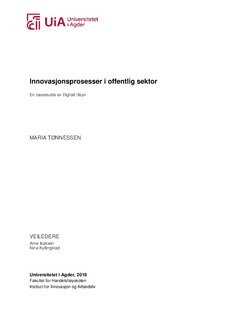| dc.description.abstract | The public sector in Norway faces several challenges related to, among other things, weak productivity development and an increasing proportion of elderly (Kommunal-og moderningseringsdepartementet, 2016a). Increased implementation of welfare technology isameasure that hasbeen initiated in the health sector to meet the challenges of increasing proportion of elderly, new user groups and scarcity of health personnel (Nærings-og fiskeridepartementet, 2019; Karlsen, 2013). Innovation in the public sector is becoming a new field of study (Karlsen, 2013) and there is little research on how innovation processes occur in the public sector. That is the background for this master thesis that addresses the research question: “What is a relevant theoretical framework for analyzing innovation processes in the public sector?”An independent theoretical frameworkhas been createdbased on the topics “innovation processes”, “innovation in the public sector” and “co-creation”. The framework is based on the 12-step model for innovation by Van de Venet al.(2000), co-creation with management, employees and suppliers, as well as the dimensions consciousness, capacity, co-creation and courage in Bason’s (2018) ecosystem for innovation in the public sector. The framework proposes that innovation processes in the public sector can follow the model of Van de Ven, Angleand Poolewhich are divided in three main periods: the initiation period, the developmental period and the implementation/termination period. Furthermore, the framework proposes that top-down co-creation and co-creation with employees are important during the initiation period, while it is important to involve all actors, including suppliers, in the last two periods. The dimensions of consciousness, capacity, co-creation and courage are, according to the framework, important in allthree periods. To investigate how relevant the proposed theoretical framework is foranalyzinginnovation processes in the public sector and whether it should be adjusted, the completion of “Digitalt tilsyn” in Risør municipality and Grimstad municipality is studied. Digitalt tilsyn is an innovationproject and a research project carried out in the healthcare sector in eight municipalities in Norway during the period 2014–2017. The project involved the implementation of sensor technology in institutions and homes to increase safety of patients. The technology sends out alarms to healthcare professionals if patients are out of their beds for a period of time or leave their homes at night. This meant, among other things, changes in the work routines for the health personnel. It has been chosen to study the completion of
vDigitalt tilsyn in the municipalities Risør and Grimstad as these municipalities are located in the same region as the author of this master thesis. Based on the research question, nine sub-questions have been developed based on the completion of Digitalt tilsyn in the initiation period, the developmental period and the implementation/termination period. In addition, it is analyzed how central co-creation was in the three periods, as well as which dimensions in the ecosystem were important in Digitalt tilsyn in the three periods. The empirical analysis shows that the independent theoretical framework is largely relevant for analyzing innovation processes in the public sector based on the study of Digitalt tilsyn. There are some elements where the completion of Digitalt tilsyn in the two municipalities do not exactly correspond to how the framework proposes that innovation processes in the public sector takes place. These elements are too little co-creation with employees, inclusion of suppliers early in the process, and too littleconsciousness of the project. This indicates some adjustments in the theoretical framework. However, discoveries from Digitalt tilsyn show that co-creation with employeesall through theprocess, co-creation with suppliers later on in the processand better consciousness of the project are elements that both the project participants and the researchers believe should be present in innovation projects and that the framework’s assumptions therefore seem relevant. | nb_NO |

